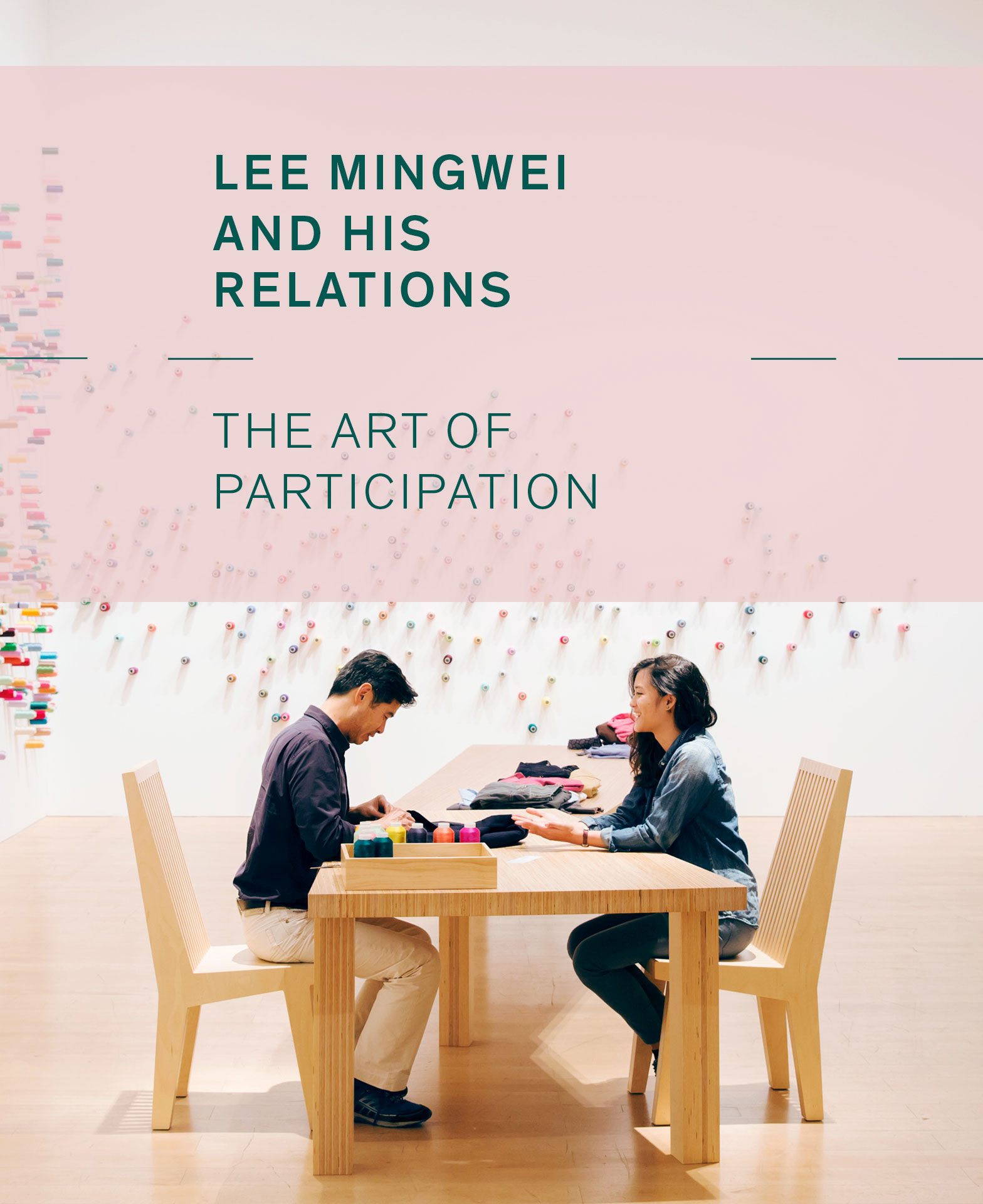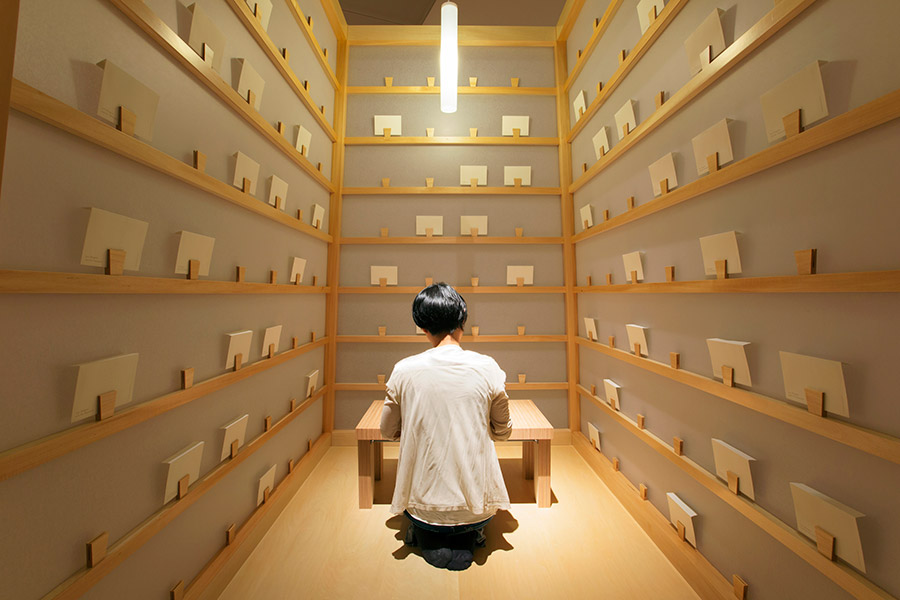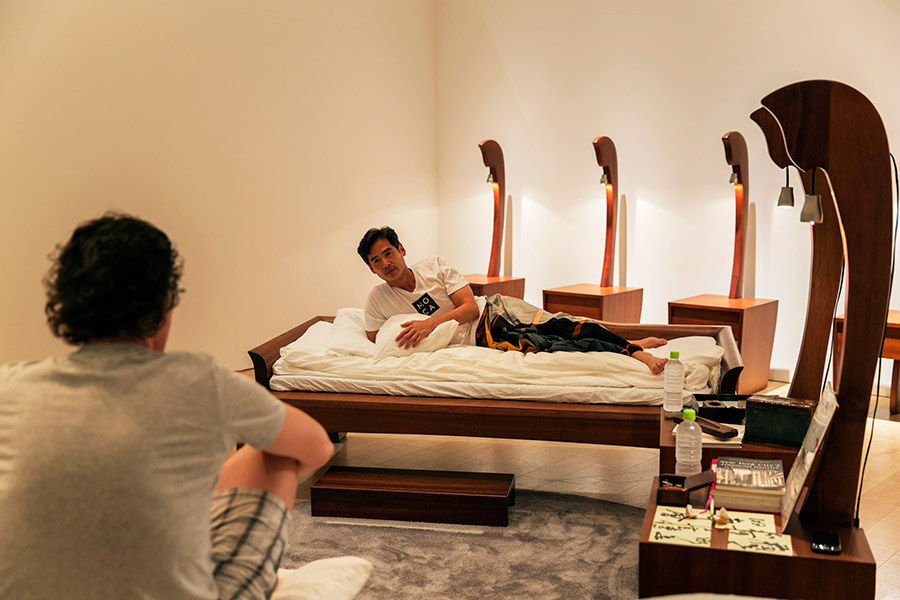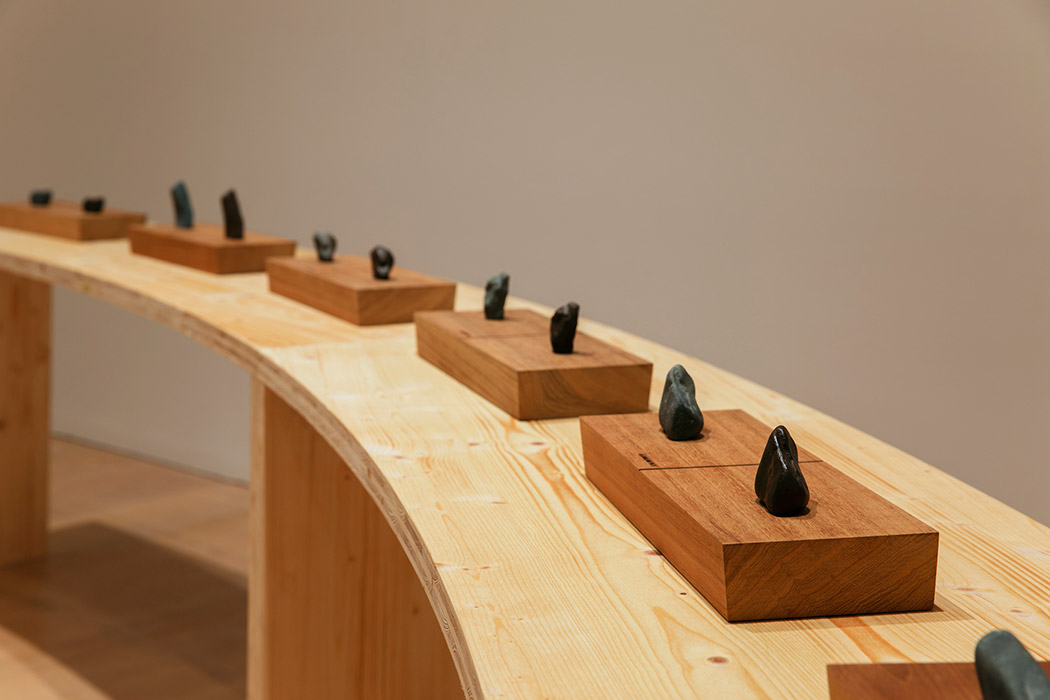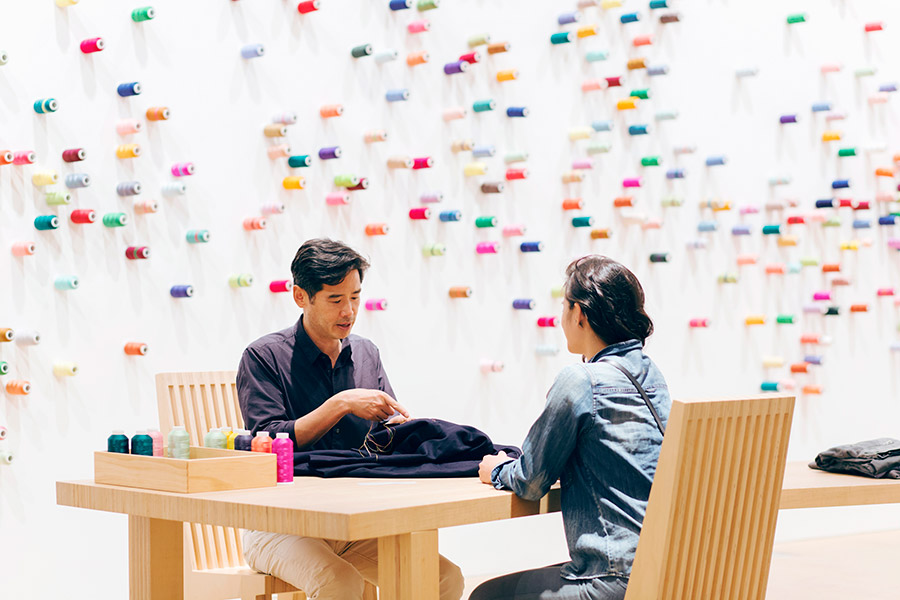Lee Mingwei and His Relations offers you a unique experience participating in works by one of the world’s most engaging international contemporary artists.
Lee’s projects involve varying degrees of participation from gallery visitors that occur before, during and after the exhibition. Alongside existing projects such as The Letter Writing Project, The Sleeping Project and Sonic Blossom, are thematically related works that provide artistic and cultural context to the artist’s practice. These feature art by Hakuin, John Cage, Allan Kaprow, Yves Klein and Lee Ufan alongside William Blake, Colin McCahon and Dane Mitchell. These pieces act as intimate reference points to the ideologies and sensibilities that inform the artist’s mode of working.
This will be the first time the artist’s work has been experienced in Auckland and is the largest retrospective of Lee Mingwei’s practice presented in the Southern Hemisphere. The exhibition was organised by Auckland Art Gallery Toi o Tāmaki and Mori Art Museum, Tokyo, curated by Mami Kataoka, Chief Curator at Mori Art Museum, in collaboration with Rhana Devenport, Director at Auckland Art Gallery.
How to participate in Lee Mingwei and His Relations.
Image credit
Lee Mingwei, The Mending Project 2009/2014
Lee Mingwei and His Relations: The Art of Participation – Seeing, Conversing, Gift-Giving, Writing, Dining and Getting Connected to the World (installation view),
Mori Art Museum, Tokyo, 2014–2015. Photo: Yoshitsugu Fuminari, courtesy Mori Art Museum, Tokyo
Projects
Lee Mingwei and His Relations gathers together eight important projects from the artist’s 20-year career. Read more about these projects below.
‘When my maternal grandmother passed way, I still had many things to say to her but it was too late. For the next year and a half I wrote many letters to her, as if she were still alive, in order to share my thoughts and feelings with her.
For The Letter Writing Project, I invited visitors to write the letters they had always meant to but never taken time for. Each of three writing booths, constructed of wood and translucent glass, contained a desk and writing materials. Visitors could enter one of the three booths and write a letter to a deceased or otherwise absent loved one, offering previously unexpressed gratitude, forgiveness or apology.
They could then seal and address their letters (for posting by the museum) or leave them unsealed in one of the slots on the wall of the booth, where later visitors could read them. Many later visitors come to realise, through reading the letters of others that they too carried unexpressed feelings that they would feel relieved to write down and perhaps share. In this way, a chain of feeling was created, reminding visitors of the larger world of emotions in which we all participate. In the end, it was the spirit of the writer that was comforted, whether the letter was ever read by the intended recipient or others.’ – Lee Mingwei
This project is generously supported by Sue Fisher Trust.
Over the centuries, a number of artists, spiritual leaders and philosophers have deepened their thinking by focusing on the realm of relationships. Similarly, the essence of Lee Mingwei’s art practice lies in the ‘relationships’ born out of people’s participation, and in thinking about ‘connections’ forming the continuity of human relations. Concepts such as gifting and trust are also integral to Lee Mingwei’s art.
This exhibition includes artworks and quotations by 12 (including currency coil) artists, spiritual leaders and thinkers ranging from the Zen priest Hakuin to contemporary artists. These people did not necessarily have a direct influence on or contact with Lee Mingwei. Rather, they are people who focused their awareness on the self and others, heaven and earth, the concept of ‘nothingness’ and ‘emptiness’ which also resonates with the Buddhist worldview, or who expressed the Zen philosophy of undertaking everyday activities mindfully.
You will also be introduced to artists who to different extents considered Eastern ideas as they thought about immateriality, silence, the infinite and the everyday. Lee Mingwei once studied under Suzanne Lacy, who herself had been a student of Allan Kaprow. Kaprow was influenced by John Cage, who attended lectures by D T Suzuki. Lee Mingwei’s relationships with a wider world not limited to the realm of art, as well as his attempts to build one-to-one relationships with strangers, suggests certain affinities. Artists from Auckland Art Gallery’s collection and from other New Zealand collections are also included. We invite you to compare these thoughts and works with the various projects undertaken by Lee Mingwei, and enjoy the resonance.
‘This project originated in a high school experience, when I travelled on an overnight train from Paris to Prague, sharing my sleeper compartment with an elderly Polish gentleman who was going back to receive his compensation after surviving the horrors of a Nazi concentration camp. At my request, he shared memories of this experience and also told me about things his family and others had told him about their time in the camp. He was the only survivor in his family. After our conversation, he bade me goodnight and went to sleep soundly.
I was the person who was not able to sleep, realising that, years ago, there were people travelling on these kinds of nights, possibly on the same track, who would not live until morning. It is only after all these years that I am able to create a project in response to the emotions I experienced that night.
In The Sleeping Project, I examine the differences between ‘sleeping’ and ‘sleeping with’. How do two strangers shape a night together into an open, profound, mutually influential encounter that they know will not be sexual? Each night, a participant chosen by lottery is asked to bring objects from the space in which they usually sleep – a clock, a photo – and spend the night with me. Next morning, the participant leaves these objects on the nightstand. During the remainder of the exhibition, these personal objects provide gallery visitors with clues about the interactions between myself/hosts and the anonymous overnight guests; interactions that suggest the range of ways in which individuals experience intimacy and trust when confronted with an unknown other.’ – Lee Mingwei
How to participate in The Sleeping Project
Dates
2016
7, 21, 28 November
5, 12 December
2017
16, 23 January
13 February
If you wish to take part in The Sleeping Project please fill out a ballot slip in the exhibition with your name, age (participants must be 18 or older), contact details, choice of date and a message. Please place the slip in the box. A Gallery staff member will serve as the host, and invite those who have been selected to participate a least one week prior to the selected date.
Those taking part will be asked, for the duration of the exhibition, to bring and lend some items from the space in which they usually sleep. The participant is asked to talk about these items with the host before sleeping. Although the content of the conversations that will unfold in the Gallery will not be recorded or made public, the personal items of those who participate in this project will be remain on the nightstands and become part of the artwork for the duration of the exhibition.
The night will be spent in The Sleeping Project exhibition space. Please be aware in advance that participants are able to use the nearby Gallery washrooms during the night, but there are no other facilities available during the night. The only refreshment during the night will be a glass of water. Participants are asked to bring their own sleep wear. Bedding and bedlinen is provided.
‘100 Days with Lily was created at a time when I was grieving the death of my maternal grandmother. I chose to live with it 24/7 for the following 100 days, as a form of ritual grieving for her. From the day I planted the lily bulb, through its germination, sprouting, blossoming, fading and death, I experienced at close hand a full cycle of its life and, by extension, my grandmother’s and my own. I randomly chose a moment in each day to document what I was doing with the lily present.
In the final presentation, text was overlaid onto five of the photographs to create images showing both various stages of lily’s life and my activities at various moments: day 1, 10:23, planting lily; day 2, 06:34, sleeping with lily; day 3, 12:05, eating with lily; day 4, 09:14, walking with lily; day 5, 07:12, meditating with lily. Lily died on day 79, at which point I postponed the exhumation and carried the now dormant lily bulb in my hands for the remaining 21 days as I ate, walked, slept, gardened, bicycled, shopped, cooked, read and contemplated, until I had lived with the lily for the full 100 days.’ – Lee Mingwei
‘While visiting New Zealand’s South Island, I was awed to discover the Pororari River Valley, a wonder of nature sculpted by glacial movement 70 million years ago. That glacier also produced millions of smooth round stones which now line the river’s bed, and which I found unusually cool and soothing when I held them in the palms of my hands. While picking up 11 of these stones as souvenirs, I suddenly realised that simply by taking them out of the river I was changing their circumstances forever. When I returned to Taipei, I had each of the 11 stones replicated in bronze, yielding 11 pairs, one original and one bronze replica.
This project centres on two ideas. First is the notion of ownership. What does it mean to own something, either natural or manmade? Second is the concept of value. Which stone is more precious, the natural stone or the fabricated one?
I ask those who become the owners of these stone pairs to decide when, where and how to discard one of them, a decision involving considerations of ownership, control, value and loss. It is this thinking/valuing process that I believe to be the heart of the project, not the stone pairs themselves.’ – Lee Mingwei
‘The Mending Project is an interactive conceptual installation in which I use very simple elements – thread, colour, sewing – as points of departure for gaining insights into the relationships among self, other and immediate surroundings. It also constitutes an act of sharing between myself and a stranger.
Visitors initially see a long table, two chairs and a wall of colourful cone-shaped spools of thread. During Gallery hours, I or a host are seated at that table, to which visitors could bring various damaged textile articles, choose the colour of thread they wish, and watch as I mend the article. The mended article, with thread ends still attached, is then placed on the table along with previously mended items. Owners return to the Gallery to collect their mended articles on the last day of the exhibition.
The act of mending takes on emotional value as well, depending on how personal the damaged item is, e.g., a favourite shirt versus an old but little-used tablecloth. This emotional mending is marked by the use of thread which is not the colour of the fabric around it, and often colourfully at odds with that fabric, as though to commemorate the repair. Unlike a tailor, who will try to hide the fact that the fabric was once damaged, my mending is done with the idea of celebrating the repair, as if to say, “Something good was done here, a gift was given, this fabric is even better than before.”’ – Lee Mingwei
‘During the annual Jewish havdalah ceremony, performed at the end of shabbat, a ‘Spice Box’ is passed around so that its fragrant scents may be enjoyed and recalled later during the secular work week. Commissioned by The Contemporary Jewish Museum, I have interpreted the spice box as a kite in the form of the mythical Taiwanese goddess NuWa who, according to legend, patched up the sky after GongGong, the god of water, ripped a huge hole in it during a battle with ZhuRong, the god of fire. She made this repair with a gigantic multicoloured fabric she had woven from human dreams and emotions. After using up all the fabric, there remains a small hole. The only thing she could do, in order to save her human children, is to patch up this hole by throwing herself against it.
Ancient Taiwanese tradition holds that we experience life as having four flavours: suan (sour), tien (sweet), ku (bitter) and la (spicy). The real project here is not the kite itself; it would be the ritual of writing down one’s associations with suan, tien, ku and la on to the kite, then sending it aloft so NuWa can use the feelings to go on mending the sky.’ – Lee Mingwei
‘Sonic Blossom came into existence while I was caring for my mother as she recuperated from surgery recently. We found great comfort in listening to Franz Schubert’s Lieder. These songs came as an unexpected gift to us, one that soothed us both and clearly helped with her healing. At another level, seeing my own mother weak and ill made her (and my) mortality suddenly very real; aging, disease and death were no longer abstractions to me, but immediate and present. One day she – and I – will be gone. Like Schubert’s Lieder, our own lives are brief, but all the more beautiful because of this.
In this project created for the inaugural exhibition of the National Museum of Modern and Contemporary Art, South Korea, I wanted to use these songs as a transformative gift to the visitors who encounter these moving Lieder. Each singer has to learn one of the five chosen Lieder. During dedicated hours, the singer meanders in the gallery, finding a visitor that s/he thinks might enjoy receiving this sonic gift by approaching them with the question: ‘May I give you a gift of song?’ This is when the song is sung. This happens sporadically in time – the folding and unfolding of a ‘Sonic Blossom’.’ – Lee Mingwei
Repertoire
Sonic Blossom times
The project will take place each week on Thursday, Friday, Saturday and Sunday between 12–4 pm.
Performers
The Gallery and the artist wish to thank the staff and students of The University of Auckland School of Music for generously facilitating this project.
This project is generously supported by Chartwell Trust.
Tickets
Buy tickets online or purchase on any day of the exhibition from the Gallery's information desk.
Any-day admission
General admission $12.50
Concessions $10
Children 12 and under FREE
Members FREE – sign up to become a Member
Partner offers
Rialto Cinemas Cine Buzz members $10
Delegates at Auckland Conventions’ venues $10
More information
Prices include GST. Booking and delivery fees, where charged, are additional to the admission price.
Concession rate applies to CSC holders, Seniors and Students with ID. Children 14 and under must be accompanied by an adult. Members must present a valid membership card.
All education group visits to Lee Mingwei and His Relations for 10 or more people should be booked at least two weeks in advance – see the Visit section below for further information.
Visit
Participating in the exhibition
Mending, letter writing, sleeping and receiving the gift of song are just some of the ways you can experience Lee Mingwei and His Relations: The Art of Participation. These projects involve varying degrees of participation from gallery visitors that occur before, during and after the exhibition.
The Mending Project
For this project you are invited to bring articles of clothing, fabric dolls and other textile items which you would like to have repaired or mended. The host, seated at the other side of the table, will converse with you while mending these objects using colourful spools of thread. Occasionally, the artist himself will be present as a host. You are asked, for the duration of the exhibition, to lend these mended objects to be displayed still connected to threads on the walls of the gallery. Towards the close of the exhibition, the beautiful threads that hang down from the walls will gradually multiply to form a complex web.
Hosts will be present daily from 10.15 am to 4.15 pm.
The Sleeping Project
Dates
2016
7, 21, 28 November
5, 12 December
2017
16, 23 January
13 February
If you wish to take part in The Sleeping Project please fill out a ballot slip in the exhibition with your name, age (participants must be 18 or older), contact details, choice of date and a message. Please place the slip in the box. A Gallery staff member will serve as the host, and invite those who have been selected to participate a least one week prior to the selected date.
Those taking part will be asked, for the duration of the exhibition, to bring and lend some items from the space in which they usually sleep. The participant is asked to talk about these items with the host before sleeping. Although the content of the conversations that will unfold in the Gallery will not be recorded or made public, the personal items of those who participate in this project will be remain on the nightstands and become part of the artwork for the duration of the exhibition.
Sonic Blossom
Sonic Blossom is a free component of Lee Mingwei and His Relations and takes place outside of the level 1 exhibition spaces.
Within the Gallery, a singer will find someone to whom they will offer a gift of song — an intangible gift that is meant solely for that person. Like a song that comes into being before vanishing again, our own lives are transient and short-lived — but perhaps all the more beautiful for that fact.
The project will take place each week on Thursday, Friday, Saturday and Sunday between 12–4pm.
Groups
All education group visits to Lee Mingwei and His Relations for 10 or more people should be booked at least two weeks in advance of your visit.
Tours will include an introduction to Lee Mingwei and His Relations and a selection of artworks and ideas in the exhibition. The duration and nature of your tour can be negotiated with our Education team when you book.
Booking is strongly recommended and booked groups will be prioritised. Large groups will be admitted into the exhibition in smaller groups.
To make a booking, email us with the details of your group, group size and preferred date(s) and time(s) of visit. Payment can be made at the Gallery's front desk on the day of your visit.
Early childhood, primary, secondary and tertiary education group bookings
For all education groups on a general visit to Lee Mingwei and His Relations, we offer entry to the exhibition and the support of our Volunteer Guides for your group visit.
Early childhood groups FREE
Primary school groups FREE
Secondary school groups $5
Tertiary and ESOL groups $10
Adult helpers (per person) $10
Cost per person, for groups of 10 or more people. Bookings essential for guided tour.
Adult education group bookings
Adult education groups $12.50
Cost per person, for groups of 10 or more people. Bookings essential for guided tour.
FAQs
Lee Mingwei and His Relations is on show at Auckland Art Gallery from Saturday 5 November 2016 – Sunday 19 March 2017. The exhibition is open during normal Gallery hours, 10am–5pm.
See the Tickets section above for full details. For online tickets, Eventfinda's standard terms and conditions apply.
Gallery Members receive free unlimited entry to Lee Mingwei and His Relations and all ticketed exhibitions at Auckland Art Gallery.
Yes. Bookings for education groups (including adult education groups) of 10 or more people should be made by emailing education@aucklandartgallery.com with the details of your group, group size and preferred date(s) and time(s) of visit.
Booked groups will be prioritised.
Any-day tickets provide you with exhibition admission on a single day only, but you may visit the exhibition more than once during that day.
Auckland Art Gallery Members and Members' Guests receive FREE unlimited entry to Lee Mingwei and His Relations.
We recommend allowing at least 60 minutes to view Lee Mingwei and His Relations.
Free daily tours will include collection and building information but will not visit this exhibition.
Yes, it is accompanied by a full and varied visitor programme. See What’s on for details. You can also subscribe to our fortnightly enewsletter to receive the latest information on upcoming events straight to your inbox – sign up at the bottom of any page on our website.
No. Entry to Auckland Art Gallery Toi o Tāmaki is free. The Todd Foundation Creative Learning Centre, E H McCormick Research Library, The Māori Portraits: Gottfried Lindauer’s New Zealand and all other exhibitions remain free of charge.
Unless you are part of a booked group or visiting with a school, Lee Mingwei and His Relations is a self-guided exhibition. However, we provide you with a free visitor guide to help you get the most from your visit.
The Gallery is busiest on weekends – if you can only come during the weekend earlier is best (10am–12pm). If you’re visiting during the week, afternoons are generally quieter (2–5pm).
Note that the Sonic Blossom project will take place each week from Thursday – Sunday between 12–4 pm.
Yes, Lee Mingwei and His Relations: The Art of Participation will be available for purchase in our shop on the ground level for $75 ($67.50 for Members). Published by the Mori Art Museum, Tokyo, the 242-page bilingual publication features essays from Mami Kataoka, Lee Sook-Kyung, Harvey Molotch and Glenn Wharton.
Yes. You are welcome to take photographs for personal use, but please do not use the flash. View the Gallery's full photography policy. Share your photos from the exhibition on social media with #leemingwei.
